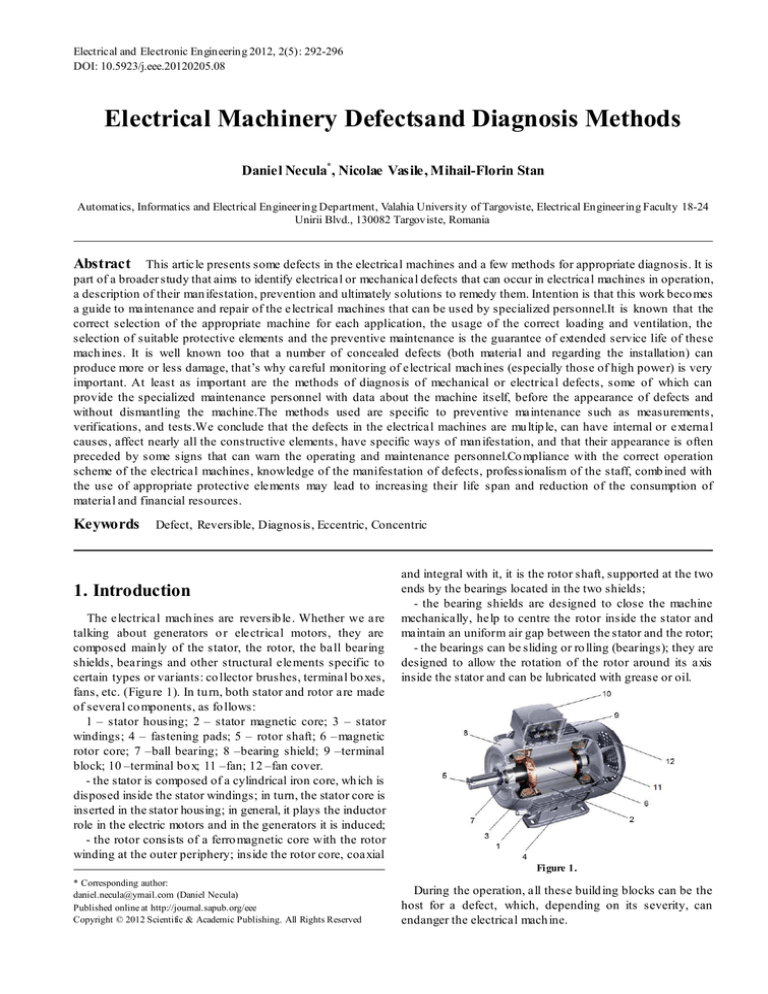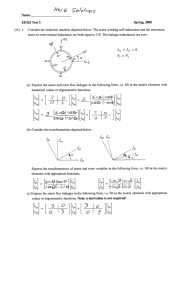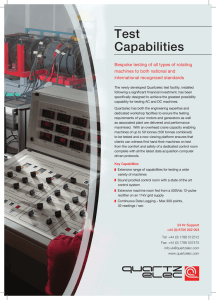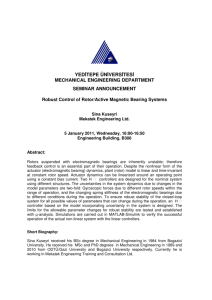
Electrical and Electronic Engineering 2012, 2(5): 292-296
DOI: 10.5923/j.eee.20120205.08
Electrical Machinery Defectsand Diagnosis Methods
Daniel Necula* , Nicolae Vasile, Mihail-Florin Stan
Automatics, Informatics and Electrical Engineering Department, Valahia Univers ity of Targoviste, Electrical Engineering Faculty 18-24
Unirii Blvd., 130082 Targoviste, Romania
Abstract This article presents some defects in the electrical machines and a few methods for appropriate diagnosis. It is
part of a broader study that aims to identify electrical or mechanical defects that can occur in electrical machines in operation,
a description of their man ifestation, prevention and ultimately solutions to remedy them. Intention is that this work beco mes
a guide to maintenance and repair of the electrical machines that can be used by specialized personnel.It is known that the
correct selection of the appropriate machine for each application, the usage of the correct loading and ventilation, the
selection of suitable protective elements and the preventive maintenance is the guarantee of extended service life of these
mach ines. It is well known too that a number of concealed defects (both material and regarding the installation) can
produce more or less damage, that’s why careful monitoring of electrical mach ines (especially those of high power) is very
important. At least as important are the methods of diagnosis of mechanical or electrical defects, some of which can
provide the specialized maintenance personnel with data about the machine itself, before the appearance of defects and
without dismantling the machine.The methods used are specific to preventive maintenance such as measurements,
verifications, and tests.We conclude that the defects in the electrical machines are mu ltip le, can have internal or external
causes, affect nearly all the constructive elements, have specific ways of man ifestation, and that their appearance is often
preceded by some signs that can warn the operating and maintenance personnel.Co mpliance with the correct operation
scheme of the electrical machines, knowledge of the manifestation of defects, professionalism of the staff, comb ined with
the use of appropriate protective elements may lead to increasing their life span and reduction of the consumption of
material and financial resources.
Keywords
Defect, Reversible, Diagnosis, Eccentric, Concentric
1. Introduction
The electrical mach ines are reversib le. Whether we are
talking about generators o r electrical motors, they are
composed main ly of the stator, the rotor, the ball bearing
shields, bearings and other structural elements specific to
certain types or variants: co llector brushes, terminal bo xes,
fans, etc. (Figu re 1). In tu rn, both stator and rotor are made
of several co mponents, as fo llows:
1 – stator housing; 2 – stator magnetic core; 3 – stator
windings; 4 – fastening pads; 5 – rotor shaft; 6 – magnetic
rotor core; 7 –ball bearing; 8 –bearing shield; 9 –terminal
block; 10 –terminal bo x; 11 –fan; 12 –fan cover.
- the stator is composed of a cylindrical iron core, wh ich is
disposed inside the stator windings; in turn, the stator core is
inserted in the stator housing; in general, it plays the inductor
role in the electric motors and in the generators it is induced;
- the rotor consists of a ferro magnetic core with the rotor
winding at the outer periphery; inside the rotor core, coaxial
* Corresponding author:
daniel.necula@ymail.com (Daniel Necula)
Published online at http://journal.sapub.org/eee
Copyright © 2012 Scientific & Academic Publishing. All Rights Reserved
and integral with it, it is the rotor shaft, supported at the two
ends by the bearings located in the two shields;
- the bearing shields are designed to close the machine
mechanically, help to centre the rotor inside the stator and
maintain an uniform air gap between the stator and the rotor;
- the bearings can be sliding or ro lling (bearings); they are
designed to allow the rotation of the rotor around its axis
inside the stator and can be lubricated with grease or oil.
Figure 1.
During the operation, all these build ing blocks can be the
host for a defect, which, depending on its severity, can
endanger the electrical mach ine.
293
Electrical and Electronic Engineering 2012, 2(5): 292-296
The causes of failure of the electrical machines can be
internal or external. Internal defects can be mechanical or
electrical. Regarding the category of mechanical defects, we
can note:
- the eccentricity of the rotor to the stator, which may have
originated either in fau lty workmanship or loosening bolts
fixing the bearing shields in the stator housing or advanced
wear of the bearing shields;
- rotor shaft bending, possibly due to its excessive heating
caused by frict ion in the bearings or frict ion between rotor
and stator;
- premature wear of the bearings or their permanent
damage due to the loss of lubricant with different causes (non
maintenance program, breakdown of the oil lubricating
circuit, etc.);
- d isplacement of the coils due to the electrodynamic
efforts they are under and an insufficient fixing; weakening
notch fixation in these coils causes vibrations and due to the
friction occurring between the coil and the core short circu it
faults can occur.
All the defects listed above are accompanied by vibrations
of the mach ine and noise.
Fro m the category of internal electrical fau lts the
following can be mentioned:
- disruptions of the rotor cage bars or coils;
- short circuits between coil turns or between d ifferent
coils or earthing caused by the destruction of insulation; it
should be mentioned here that comp liance with the machine
load and operating temperature limit is very important for the
lifetime of the machine;
- stator and rotor windings interruptions, separation of the
contact blades of the rotor winding machine collectors;
- d isplacement o f the rotor winding heads fro m the wiper
blades of the collector.
A frequently encountered phenomenon during the
operation of the electrical machines is the decrease of the
insulation resistance due to its moistening.The moistening of
the insulation occurs especially during the cold season and
occurs when the machine is shut down, when the mach ine is
hot; the cold outside air generates the possibility of
condensation.The phenomenon may have a higher
magnitude as stops and starts are more frequent. Moistening
of the insulation can also occur due to accidental ingress of
water or other fluids into the machine, during the operation
or during repairs.
The insulation of the electrical machines is represented by
the set of materials with electrical insulating properties,
which separates electrically the conductive parts under
voltages with different phases or polarit ies, or the conductive
parts fro m the metal housing of the machine (ferro magnetic
stator core or rotor, and housing).
The insulation is of particular importance because the
good functioning and life of the mach ine largely depends by
its qualities. Of operating experience it may be established
that about 40% of failures are due to problems of electrical
mach inery insulation.Due to this reason special attention is
given to testing and checking the insulation, both during
manufacture and throughout the lifetime of the mach ine.
Tests taking place in the factory have a dual purpose, namely
to validate the solution used (type test) and to certify the
quality of execution (indiv idual tests).
During the operation of the electrical machines, the tests
and checks have a prophylactic role (preventive
maintenance), and a certificat ion of quality for the
maintenance works. During the operation, the insulation is
subject of electrical, thermal and mechanical stress, which
leads to aging.
The higher the demands the aging occurs mo re rapidly and
the lifetime of the machine decreases. Associated or not
associated with aging, the frequency of electrical defects gets
higher with the decrease of the insulation resistance, leading
to the disposal of the machine. Insulation problems are
specific to both the stator windings and the rotor.
External causes of failure of the electrical mach ines can be
in turn mechanical, electrical or related to the environment
they are used in.
a- Mechanical causes: overload, uneven load over time,
shock fro m the driven element, and wrong installation of the
electrical machine on the base or on the working machine;
b- Causes of electrical nature: fluctuations in supply
voltage within large limits, unbalanced voltages on the three
phases of the power network, inadequate protection or its
downtime.
Causes due to the environment in wh ich the mach ine
works: temperature, hu mid ity, particu late matter, etc.
2. The Electrical Faults of the Stator
As mentioned previously, the most co mmon electrical
defects of the stator of the electrical machine are the
interruption of the coils (open coils) or short circuits between
turns of the same phase or different phases.
Interruption of a winding during machine operation
produces a lo w torque and speed and increasing current in
the other two phases. If the motor is equipped with p rotection
against operation in two phases, it will stop functioning and
will limit the fault . In this case, there is a chance for the coil
to be repaired and once the insulation is rebuilt to recover the
electrical motor. In the event of short circuits between turns,
the effects are more severe, the defect leading to the disposal
of the mach ine to replace the coil.
3. Methods of Diagnosis for the
Electrical Faults of the Stator
To diagnose the electrical faults of the stator, several
methods are known whose principles are based on the very
specific effects of these defects: asymmetries, lo w torque,
increasing phase currents on the working windings.
Regarding the importance of electrical machines failures,
experts’ opinions are div ided. So me authors (A. Bellin i, F.
Filippetti, C. Tassoni, G. Capolino) believe that the electrical
faults due to the condition of the winding and insulation are
Daniel Necula et al.:
Electrical M achinery Defectsand Diagnosis M ethods
essential, wh ile others (S. Nandi, Toliyat H., Li X.) consider
that mechanical breakdowns, especially those of the bearings,
are more important.
Fro m our point of v iew, all types of defects are important.
Although some are insignificant at first, they can lead to
major defects that can destroy the machine.
There are various methods of diagnosis of the stator faults.
One of them, developed by Filippetti, proposed transverse
admittance as an indicator of failure, this resulting from the
ratio of negative sequence component of stator current and
the supply voltage positive component. The method is based
on the hypothesis that the electrical mach ine with
n short-circuit turns, therefore unbalanced, can be
N
assimilated to a symmetrical machine to which n turns are
N
added, which corresponds to the shorted turns (Figure 2).
a
b
Figure 2. a) the stator windings connected in star schema with one phase
short circuit between turns; b) the equivalent circuit
4. Mechanical Failure – Rotor
Eccentricity
Mechanical defects can occur either due to wear over time
of the various elements of the electric motor or as a result of
mechanical shock transmitted at some point fro m the d riven
element. These defects are often generated by issues such as:
inappropriate building solutions, improper choice of
materials, form or wrong assembly of couplings, improper
balance etc. In general, however, the mechanical stress the
composing elements and the electrical machine as whole are
subjected to does not reach the state of elastic deformation.
The mechanical shocks due to uneven load, taken on the
rotor shaft, are transmitted to all the build ing blocks of the
mach ine, in the form of vibrations, over time leading to
premature wear and at the mo ment to the heating of the
mach ine.
Besides the vibrations generated by taking over the shocks
fro m driven element, there are times when the machine has
its own vibration due to internal causes, such as: unbalanced
rotating part (rotor), weakening of the magnetic core wedges
rotor shaft rotor, pressing failure or weakness in the
functioning of the stator and rotor magnetic core, advanced
tread wear of the bearings.The imbalance of the rotating
parts is one of the most common causes of vibration with all
the adverse effects on the durability of the machine.
In practice there are two types of imbalance, namely:
- imbalance in a single plane (static);
294
- imbalance in two or mo re p lanes (dynamic).
One of the situations in which the imbalance of the rotor
may occur (in rotor winding electrical machines) is for the
rewinding. Non-uniform distribution of wind ing wire
channels contribute to imbalance rotor magnetic core. Other
sources of imbalance are uneven distribution of insulating
feathers and lake, of the material used for sealing the ends of
coils to the co mmutator segments, etc. Therefore, after
rewinding the rotor, special attention is given to the
balancing.
Balance must be dynamic (in at least two planes), for
example by x and y planes. Even after the execution of the
rotor balancing operation, a certain residual imbalance
remains. It is acceptable, based on experience, that the
allo wable imbalance is proportional to the rotor mass, thus
defining the specific imbalance "e" as the ratio between the
residual unbalance (kg/ mm) and the rotor weight (kg). The
specific imbalance "e" may be regarded as the eccentricity of
the center of the mass for a static imbalance (mm). Quality
grades of the balancing " G" are provided in international
standards, for each grade being provided a range of
permissible residual unbalance.
A satisfactory quality of balancing of can be done only
under a sufficiently high precision mounting of the rotor in
its camps.
5. Vibration and Noise in Bearings
The bearing vib ration and noise problem has worsened
with the expansion of the use of small d imensions bearings
(micro bearings) in the manufacture of micro motors for, and
not limited to, office electronics (eg. co mputers), where
noise of bearings may be dominant and disturbing.
Movements of the bearings co mponents (rings, cage,
rolling bodies) in actual execution and operation generates
vibration and noise very important for the situations outlined
above.It's possible that the vibration to be weak, but
propagated to other elements (in the case of electrical
mach ines to port shields bearing and stator housing) as
indirect excitation to cause important vibrations.
Practice and experimental research shows that vibration
and noise of bearings originate fro m these phenomena:
-movement of ro lling bodies (balls) on taxiways (the outer
and inner) over localized defects (voids, cracks, peeling tool,
foreign bodies fro m the grease used or accidentally
permeated into the work environment);
-movement of the rolling bodies over the rolling ways on
contact surfaces that have deviations from ideal geo metric
shape (dimensional deviations, geometric deviat ions,
roughness) or imp roper tightening;
- changes in the position of the rolling bodies depending
on the areas more or less affected of the rolling surface.
It was also found that there is a strict dependence between
the size or shape deviations game and the noise and vibration.
Also should be noted that bearing construction and type of
contact (surface or punctual) in fluence the noise and
295
Electrical and Electronic Engineering 2012, 2(5): 292-296
vibration (eg. the same size, roller bearings are 5-14 dB
louder than the ball bearings).Radial load has a smaller
influence than the axial load on the level of noise and
vibration while the rotation speed especially influences this
level.
One of the effects of a high level of vib ration of bearings
may be widening holes of port shields bearings where they
lean, and can lead to eccentricity of the rotor to the stator.
Therefore, one of the co mmon faults of rotating electrical
mach ines is the occurrence of the rotor to the stator
eccentricity. This defect may have its origin in an assembly
error, or may be caused by loosening bolts fastening the
shield bearings during operation, or deformation of the bore
that are holding the bearings, which leads to changes in air
gap uniformity.
In all these cases, the specific element is the appearance of
imbalances that disrupt the movement of rotor torque,
generating noise and vibration. In severe cases, frict ion may
occur between the rotor and the stator with dramat ic
consequences on the state of the machine. For these reasons,
diagnosis and early detection of defects without dismantling
the machine is very important.
6. Diagnosis of Rotor Eccentricity
Rotor eccentricity has a static and a dynamic co mponent,
in pract ice both manifesting simultaneously. Diagnosis of
rotor eccentricity can be done by monitoring the magnetic
flu x crossing the air gap.
Appropriate side of eccentricity fault frequencies is:
f ex = [(kN r ± n d ) ⋅
1− s
± m] ⋅ f1
p
where: k is a constant positive integer, Nr is the nu mber of
rotor bars, p is the number of pole pairs, n d is the order of
eccentricity (n d = 0, for static eccentricity and n d = 1, for
dynamic eccentricity), s is the motor slipping, m is the order
of harmonic present in the power source of the motor (m = 1,
3, 5, ...) and f1 is the frequency of the source.
In the paper Condition Monitoring and Fault Diagnosis of
Electrical Motors, the authors show that the method used to
detect rotor eccentricity provides satisfactory results only for
a certain co mb ination of nu mbers of pairs of poles and rotor
slots.
7. Trends for the Future of Electrical
Machines
In terms of the future of the electrical machines, concerns
are directed towards increasing dynamic performance
(torque response), using new encapsulation technologies,
development of new types of insulating materials that allow
temperatures up to 200 degrees Celsius, using amorphous
metallic powders in place of siliceous sheets for the magnetic
cores, making of the electric motors without notches, high
frequency operation that reduces gauge.
Increasing the lifetime of the machine, increasing energy
efficiency to reduce energy consumption to min imize
environmental impact are also pressing concerns of the
specialists in the field.
8. Conclusions
Figure 3. a) centered rotor b) eccentric rotor
1-Rotor shafte-Rotor eccentricity
2-Rotor magnetic core
3-Stator
4-Air gap
Spectral co mponents sides have a frequency
corresponding to the eccentricity, equalling:
fex = f1 ±fr ,
where: f1 is the frequency of the power network andfr is the
frequency of the rotation of the rotor.
Static or dynamic rotor eccentricity can be identified using
the method of stator current profile analysis (MCSA).
The electrical machines are co mp lex systems in which a
series of phenomena as heating and vibrat ion take place, both
of mechanical and electro magnetic nature.
Defects in the electrical mach ines can be mechanical or
electrical, caused by internal or external factors, or by the
environmental conditions in which they are functioning. It
can be said here that between the electrical machine and the
environment there is an interaction, in that on one hand the
environment (mo isture, dust, temperature) affects the
functioning the machine and on the other hand, the heat
dissipated during machine operation affects the environ ment.
Integrated building of the electrical machines allows the
embedding of different types of sensors (temperature,
vibration) into their co mponents, making possible the
detection of incip ient faults and allowing preventive
maintenance measures.
The recent years imposed edge technology in the
construction of electric machines, new materials are used
which allow obtaining h igh power densities / kg, decreasing
gauge and increased reliab ility.
Daniel Necula et al.:
Electrical M achinery Defectsand Diagnosis M ethods
REFERENCES
[1]
M . D. Călin, E. Helerea, I. D. Oltean, New Consideration
Regarding Frequency Influence on Soft M agnetic M aterials
Characteristics. The Third International Symposium on
Electrical and Electronics Engineering – ISEEE-2010, Galaţi,
Romania, 2010.
[2]
Daniel Necula, NicolaeVasile, M ihail Florin Stan, New
Solutions in the M aintenance of the Asynchronous Motors
with Integrated Gear and Single Demountable Bearing Shield.
Devices to Extract and Insert the Ferromagnetic Cores of the
Stator (Case Study), PROCEEDINGS OF THE 7th
INTERNATIONAL SYM POSIUM ADVANCED TOPICS
IN ELECTRICAL ENGINEERING (ATEE 2011),
University POLITEHNICA of Bucharest, Faculty of
Electrical Engineering, M ay 12-14, 2011, Bucharest,
Romania, pp.481-484, ISSN: 2068-7966.
[3]
Bellini Alberto, FilippettiFiorenzo, Tassoni Carla, Capolino
Gérard-André, Advances in Diagnostic Techniques for
Induction
M achines.
IEEE
Transactions
on
IndustrialElectronics, Vol. 55, No. 12, December 2008, 41094126.
[4]
N. Vasile, N. Voncila, M . Rădulescu, A. Simion, M .
Chefneux, L. Livadaru, Integrated Design Solutions for
Electrical M achines for Rational Use of Natural and Artificial
Resources, CIT-TE ICPE Publishing House, Bucharest, 2008.
[5]
NicolaeVasile, S. Şlaiher, Electrical Servomotors, Electra
Publishing House, Bucharest, 2002.
[6]
M ihail Florin Stan, Horia Andrei, M odern Electrical
Engineering.
Electotechnic
and
Electromechanical
296
Converters. Theory and Applications, vol. 2, Bibliotheca
Publishing House, Târgovişte, România, 2010.
[7]
M . Filip, E. Helerea, I. C. Roşca, Considerations about the
Electrical Engine Vibrodiagnosis, AFASES, Brasov, 20-22
M ay 2009.
[8]
M . Filip, I. C. Roşca, E. Helerea, Low Power Induction
M otors Vibration Tests. Proceedings of the X-th International
Symposium AVM S’2009, pp. 142-147, ISSN 1843-0902,
Timişoara, M ay 28, 2009.
[9]
M . Filip, E. Helerea, On the Induction Motor Vibration
Testing. Proceedings of the 5-th International Conference on
Interdisciplinarity in Education. ICIE’10, M ay 6-8 2010,
Tallinn, Estonia, ISSN 1790-661X.
[10] S. Nandi, H. Toliyat, X. Li, Condition M onitoring and Fault
Diagnosis of Electrical M otors: A Review. IEEE
Transactions on Energy Conversion, Vol. 20, No. 4,
December 2005, pp. 719-728.
[11] M ihail Florin Stan, M arcel Ionel, M . O. Ionel, Daniel Necula,
AC M achines with Two Radial Air-gaps. A Variant of
Asynchronous M achine with Sectioned Arbor and Two
Bearings, Scientific Bulletin of the Electrical Engineering
Faculty, no. 1(15) / 2011, Bibliotheca Publishing House,
Târgovişte, pp. 37-42, ISSN 1843-6188.
[12] M arcel Ionel, M ihail Florin Stan, M . O. Ionel, Daniel Necula,
Development of Generalized M athematical M odels for
Variable Speed Electric M achines, Scientific Bulletin of the
Electrical Engineering Faculty, no. 1(15) / 2011, Bibliotheca
Publishing House, Târgovişte, pp. 19-24, ISSN 1843-6188.



